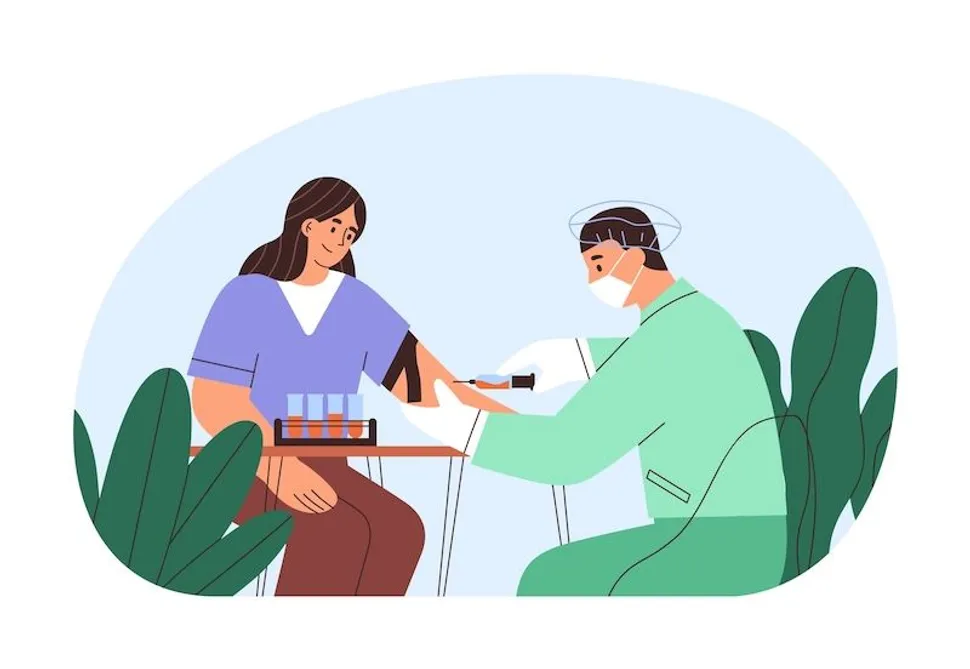Monitoring Minimal Residual Disease in Blood with EasyM

For patients with multiple myeloma, achieving complete remission is a primary goal of treatment. However, even after successful treatment, some cancer cells may remain undetectable by imaging or blood counts. This condition, known as minimal residual disease (MRD), can lead to future relapse.
How is MRD Monitored?
MRD assessment has become increasingly important in managing multiple myeloma. By detecting early if there are any residual cancer cells, doctors can adjust treatment plans and potentially improve long-term outcomes.
Traditionally, MRD testing relied on bone marrow aspiration or biopsy, and there has been a major effort in the field to develop more sensitive and less invasive ways to assess MRD, such as using imaging techniques and blood tests.
Watch our recent webinar ‘Is MRD Negativity the Goal of Myeloma Treatment?’ with Dr. Malin Hultcrantz from Memorial Sloan Kettering Cancer Center to learn more about MRD bone marrow- and blood-based technologies.
Introducing EasyM: A Novel Blood Test for MRD Monitoring
EasyM is a groundbreaking new technique developed by Rapid Novor that utilizes clonotypic peptide mass spectrometry (MS) to detect M-protein secreted by myeloma cells directly from a patient's blood serum. This minimally invasive approach offers several advantages over traditional methods:
- Easier and more convenient: EasyM requires a simple blood draw, eliminating the discomfort and potential risks associated with bone marrow aspiration and allowing for more frequent assessments.
- Detecting disease throughout the entire body: A bone marrow biopsy only takes a sample from one small area. There's a chance that this sample might miss myeloma cells if they're not clustered in that specific spot (called sampling bias). Blood tests can overcome this limitation because myeloma proteins can be found throughout your bloodstream, which can give doctors a more complete picture of the disease, including extramedullary disease.
- Enhanced sensitivity: Studies have shown that EasyM is an ultra-sensitive assay, able to continue to detect and monitor M-protein in samples that were MRD-negative by next-generation flow cytometry (NGF), the current gold standard for MRD assessment in multiple myeloma.
- Greater specificity: EasyM offers high specificity by tracking each patient’s unique M-protein signature, making it advantageous in cases where other methods might be affected by interference from other proteins (such as during treatment with anti-CD38 monoclonal antibodies).
- Earlier detection: EasyM can potentially predict disease progression earlier by detecting rapid and significant increases in M-protein even while patients are still in remission or complete response.
This information can empower doctors to tailor treatment plans based on individual patient needs and MRD status. Of note, because EasyM specifically tracks the M-protein in blood, it would not be helpful for patients with nonsecretory multiple myeloma.
Important Note About Detecting M-protein in Blood
It is important to understand that detecting M-protein in the blood doesn't necessarily mean relapse, especially soon after treatment. Even when there are no malignant cells detectable in the bone marrow, there might still be M-protein detectable in blood. This is because it takes time for the body to completely clear the M-protein from the bloodstream. Therefore, MRD in blood with tests like EasyM is more about monitoring changes from a baseline measurement than a single value at a given point in time.
EasyM Validation and Ongoing Research
Clinical studies have shown promising results for EasyM, with undetectable MRD (negative MS-MRD) being linked to improved patient outcomes like progression-free survival (PFS) and overall survival (OS).
Ongoing research is aimed at evaluating EasyM's long-term efficacy in monitoring MRD and its impact on treatment success. In addition, continuous comparison with other established MRD methods at different treatment time points is crucial to understanding when and how EasyM can be helpful.
By addressing these questions and continuously refining EasyM, this innovative blood test holds immense promise for MRD monitoring in multiple myeloma, ultimately leading to better treatment decisions and improved patient outcomes.
EasyM has been certified by CLIA since March 2023, and it is available to order in all US states except NY. Although EasyM is not yet covered by private health insurance or Medicare/Medicaid, you can learn more about EasyM at www.easym.com and discuss with your medical team how to access it.
Learn more about minimal residual disease monitoring with HealthTree University for Myeloma:
Sources:
- Monitoring Minimal Residual Disease in Patients with Multiple Myeloma by Targeted Tracking Serum M-Protein Using Mass Spectrometry (EasyM)
- Rapid Novor's Blood Test for Multiple Myeloma Monitoring is CLIA Certified for Clinical Use in the US
- EasyM - Information for Patients
- EasyM - Publications and Clinical Trials
For patients with multiple myeloma, achieving complete remission is a primary goal of treatment. However, even after successful treatment, some cancer cells may remain undetectable by imaging or blood counts. This condition, known as minimal residual disease (MRD), can lead to future relapse.
How is MRD Monitored?
MRD assessment has become increasingly important in managing multiple myeloma. By detecting early if there are any residual cancer cells, doctors can adjust treatment plans and potentially improve long-term outcomes.
Traditionally, MRD testing relied on bone marrow aspiration or biopsy, and there has been a major effort in the field to develop more sensitive and less invasive ways to assess MRD, such as using imaging techniques and blood tests.
Watch our recent webinar ‘Is MRD Negativity the Goal of Myeloma Treatment?’ with Dr. Malin Hultcrantz from Memorial Sloan Kettering Cancer Center to learn more about MRD bone marrow- and blood-based technologies.
Introducing EasyM: A Novel Blood Test for MRD Monitoring
EasyM is a groundbreaking new technique developed by Rapid Novor that utilizes clonotypic peptide mass spectrometry (MS) to detect M-protein secreted by myeloma cells directly from a patient's blood serum. This minimally invasive approach offers several advantages over traditional methods:
- Easier and more convenient: EasyM requires a simple blood draw, eliminating the discomfort and potential risks associated with bone marrow aspiration and allowing for more frequent assessments.
- Detecting disease throughout the entire body: A bone marrow biopsy only takes a sample from one small area. There's a chance that this sample might miss myeloma cells if they're not clustered in that specific spot (called sampling bias). Blood tests can overcome this limitation because myeloma proteins can be found throughout your bloodstream, which can give doctors a more complete picture of the disease, including extramedullary disease.
- Enhanced sensitivity: Studies have shown that EasyM is an ultra-sensitive assay, able to continue to detect and monitor M-protein in samples that were MRD-negative by next-generation flow cytometry (NGF), the current gold standard for MRD assessment in multiple myeloma.
- Greater specificity: EasyM offers high specificity by tracking each patient’s unique M-protein signature, making it advantageous in cases where other methods might be affected by interference from other proteins (such as during treatment with anti-CD38 monoclonal antibodies).
- Earlier detection: EasyM can potentially predict disease progression earlier by detecting rapid and significant increases in M-protein even while patients are still in remission or complete response.
This information can empower doctors to tailor treatment plans based on individual patient needs and MRD status. Of note, because EasyM specifically tracks the M-protein in blood, it would not be helpful for patients with nonsecretory multiple myeloma.
Important Note About Detecting M-protein in Blood
It is important to understand that detecting M-protein in the blood doesn't necessarily mean relapse, especially soon after treatment. Even when there are no malignant cells detectable in the bone marrow, there might still be M-protein detectable in blood. This is because it takes time for the body to completely clear the M-protein from the bloodstream. Therefore, MRD in blood with tests like EasyM is more about monitoring changes from a baseline measurement than a single value at a given point in time.
EasyM Validation and Ongoing Research
Clinical studies have shown promising results for EasyM, with undetectable MRD (negative MS-MRD) being linked to improved patient outcomes like progression-free survival (PFS) and overall survival (OS).
Ongoing research is aimed at evaluating EasyM's long-term efficacy in monitoring MRD and its impact on treatment success. In addition, continuous comparison with other established MRD methods at different treatment time points is crucial to understanding when and how EasyM can be helpful.
By addressing these questions and continuously refining EasyM, this innovative blood test holds immense promise for MRD monitoring in multiple myeloma, ultimately leading to better treatment decisions and improved patient outcomes.
EasyM has been certified by CLIA since March 2023, and it is available to order in all US states except NY. Although EasyM is not yet covered by private health insurance or Medicare/Medicaid, you can learn more about EasyM at www.easym.com and discuss with your medical team how to access it.
Learn more about minimal residual disease monitoring with HealthTree University for Myeloma:
Sources:
- Monitoring Minimal Residual Disease in Patients with Multiple Myeloma by Targeted Tracking Serum M-Protein Using Mass Spectrometry (EasyM)
- Rapid Novor's Blood Test for Multiple Myeloma Monitoring is CLIA Certified for Clinical Use in the US
- EasyM - Information for Patients
- EasyM - Publications and Clinical Trials

about the author
Marta Llobet Canela
Marta believes that too many people still struggle to understand how our bodies work, making a cancer diagnosis even more overwhelming. With 10 years of experience in blood cancer, she transforms complex medical language into clear, accessible information, empowering patients to confidently advocate for themselves and participate in meaningful research at HealthTree. She loves exploring New York and always says yes to trying a new restaurant!
More on Navigating Your Health
Trending Articles
Upcoming Events




Get the Latest Multiple Myeloma Updates, Delivered to You.
By subscribing to the HealthTree newsletter, you'll receive the latest research, treatment updates, and expert insights to help you navigate your health.
Together we care.
Together we cure.
3x Faster.













